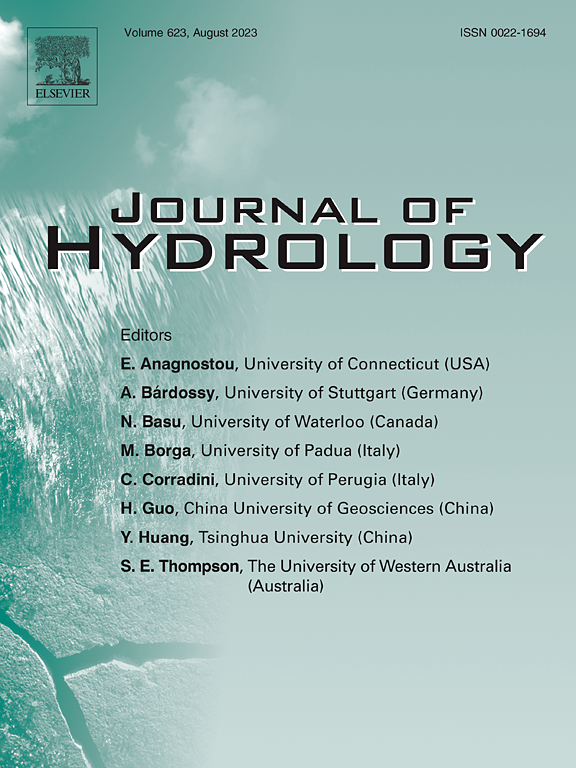基于深度学习的城市洪水超分辨模型
IF 5.9
1区 地球科学
Q1 ENGINEERING, CIVIL
引用次数: 0
摘要
气候变化和城市化加剧了城市洪水,需要高保真度和计算效率高的建模框架,以便进行有效的风险评估和缓解。本研究提出了一种基于深度学习的超分辨率(SR)模型FLO-SR,以提高城市洪水模拟的空间分辨率,同时显著降低计算成本。FLO-SR利用卷积神经网络(CNN)将低分辨率(LR)洪水图转换为高分辨率(HR)输出。该模型使用两个不同的洪水事件进行了验证:德克萨斯州休斯顿的飓风哈维(使用双三次插值的合成场景)和俄勒冈州波特兰的城市洪水事件(基于物理的模拟场景)。从图像相似度、洪水深度和淹没程度三个方面对FLO-SR进行评价。在2、4和8倍的比例因子下,fro - sr在两种情况下都实现了准确性的提高,休斯顿的平均RMSE降低了56.2、32.4和10.7%,波特兰的平均RMSE降低了24.5、33.8和44.1%。然而,在8×尺度下,由于在重建精细尺度洪水特征和LR输入的空间不连续方面的挑战,性能受到限制。为了解决这个问题,未来的改进应该包括水动力约束和增强模型泛化。尽管存在这些限制,当从4米重建2米和从8米重建4米时,FLO-SR与基于物理的建模相结合,运行时间分别减少了63%和45.7%,这凸显了它在实时城市洪水预报方面的潜力。本文章由计算机程序翻译,如有差异,请以英文原文为准。
FLO-SR: Deep learning-based urban flood super-resolution model
Urban flooding, intensified by both climate change and urbanization, requires high-fidelity and computationally efficient modeling frameworks for effective risk assessment and mitigation. This study presents FLO-SR, a deep learning-based super-resolution (SR) model, to enhance the spatial resolution of urban flood simulations while significantly reducing computational costs. FLO-SR leverages a convolutional neural network (CNN) to convert low-resolution (LR) flood maps into high-resolution (HR) outputs. The model was validated using two distinct flood events: Hurricane Harvey in Houston, Texas (synthetic scenario using bicubic interpolation) and an urban flood event in Portland, Oregon (physics-based simulation scenario). FLO-SR was evaluated in terms of image similarity, flood depth, and inundation extent. FLO-SR achieved accuracy improvements in both cases at scale factors of 2, 4, and 8×, with average RMSE reductions of 56.2, 32.4, and 10.7 % in Houston and 24.5, 33.8, and 44.1 % in Portland. However, performance at the 8× scale was limited due to challenges in reconstructing fine-scale flood features and spatial discontinuities in LR inputs. To address this, future improvements should incorporate hydrodynamic constraints and enhance model generalization. Despite these limitations, FLO-SR combined with physics-based modeling achieved up to 63 and 45.7 % runtime reductions when reconstructing 2 m from 4 m and 4 m from 8 m simulations, respectively, highlighting its potential for real-time urban flood forecasting.
求助全文
通过发布文献求助,成功后即可免费获取论文全文。
去求助
来源期刊

Journal of Hydrology
地学-地球科学综合
CiteScore
11.00
自引率
12.50%
发文量
1309
审稿时长
7.5 months
期刊介绍:
The Journal of Hydrology publishes original research papers and comprehensive reviews in all the subfields of the hydrological sciences including water based management and policy issues that impact on economics and society. These comprise, but are not limited to the physical, chemical, biogeochemical, stochastic and systems aspects of surface and groundwater hydrology, hydrometeorology and hydrogeology. Relevant topics incorporating the insights and methodologies of disciplines such as climatology, water resource systems, hydraulics, agrohydrology, geomorphology, soil science, instrumentation and remote sensing, civil and environmental engineering are included. Social science perspectives on hydrological problems such as resource and ecological economics, environmental sociology, psychology and behavioural science, management and policy analysis are also invited. Multi-and interdisciplinary analyses of hydrological problems are within scope. The science published in the Journal of Hydrology is relevant to catchment scales rather than exclusively to a local scale or site.
 求助内容:
求助内容: 应助结果提醒方式:
应助结果提醒方式:


